
a web page by Don Roberson |
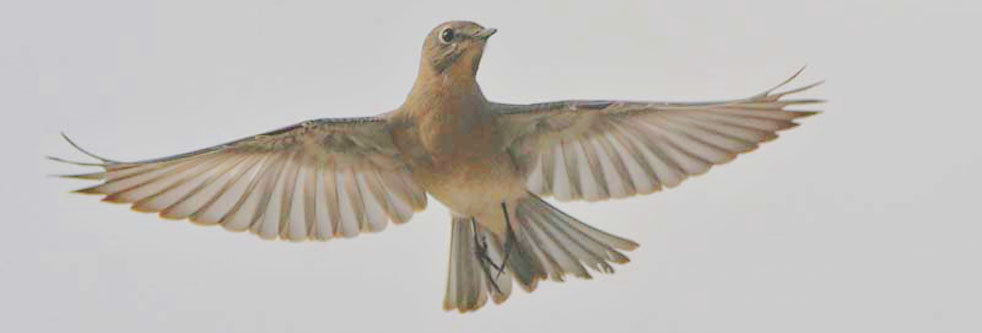 |
|||||||||
THRUSHES Turdidae |
|||||||||
|
|||||||||
Still, the species remaining in Turdidae are a fascinating group. Many are gray or brown, often paler below, with streaks or spots. Yet some drop-dead gorgeous or elegant birds remain as "thrushes," including the North American bluebird — exemplified by Mountain Bluebird — represented here by a vagrant immature in flight (above) and a wintering male (below; a gorgeous sky-blue bird against a blue sky). In the Old World, Orange-headed Thrush (left) is a splendid species, and a shy, difficult bird to see. This one cooperated only because our guide brought mealworms to a log deep in the shadows of the forest floor in winter in Thailand.
|
|||||||||
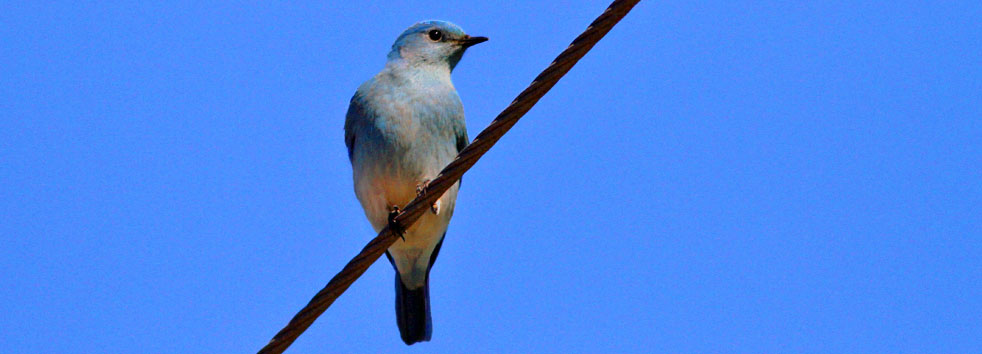 |
|||||||||
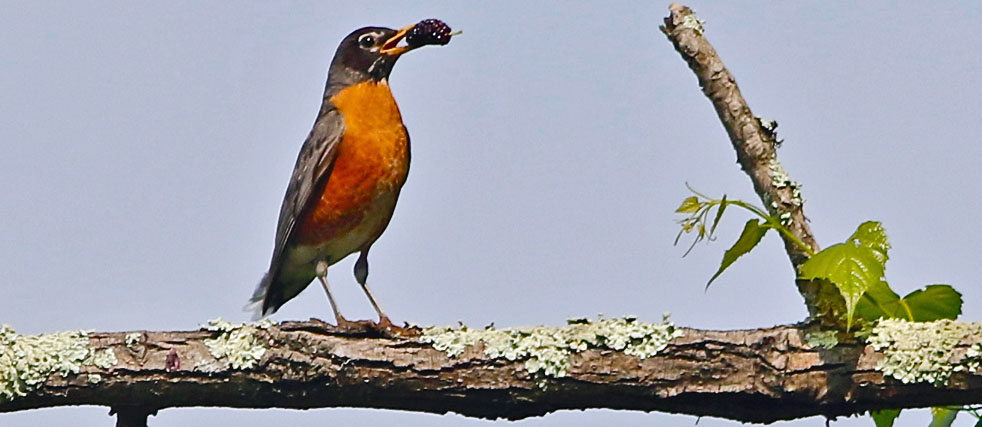 |
|||||||||
The current Turdidae has 18 genera, but half of the family (49%) are 83 species in genus Turdus. These include familiar birds like American Robin (male of eastern race, above) and Eurasian Blackbird (male, below, with beak full of insects to feed to fledgling). Both species, the robin in North America and the blackbird in Europe, are known to most people and appear often in American or European songs and literature. Turdus is the only thrush genus to occurs worldwide. In most forested continents and on many islands there is a locally common Turdus thrush. But many species are local endemics, or little known, or both. Perhaps the most confusing is the polytypic Island Thrush (right, this adult feeding a fledgling is from the highlands of Papua New Guinea ). There are at least 51 subspecies (and 39 eBird "Groups) on islands from Sumatra and Borneo to New Guinea, and then widely across the islands of the southwest Pacific. It is an extremely variable species in plumage, but "always with yellow bill, eyering and legs, plain brown to blackish upperparts from mantle rearwards, and plain underparts" (Collar 2005). Some taxa all black, or brown, or gray; some have chestnut bellies; some have gray or white or chestnut hoods. Yet their systematics remain uncertain. |
|||||||||
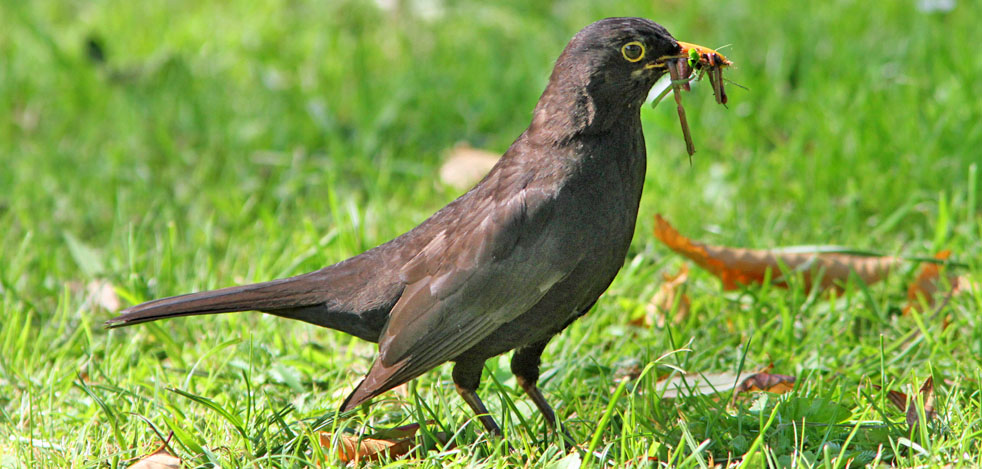 |
|||||||||
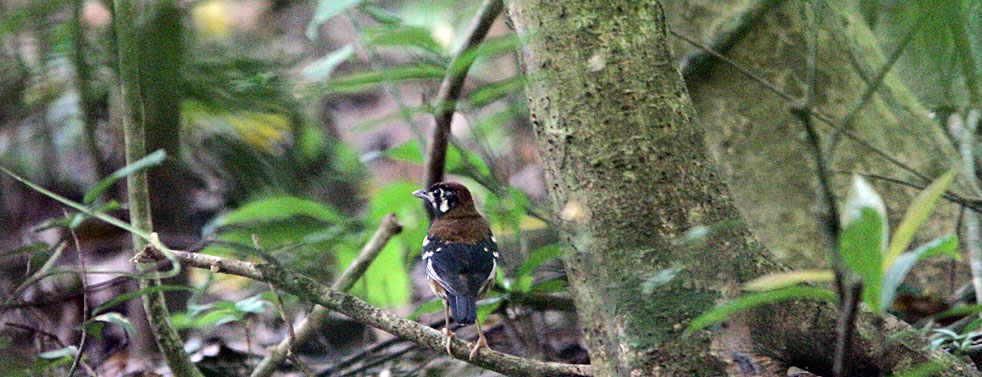 |
|||||||||
Let's consider the two other speciose genera of Old World ground-thrushes: Geokichla (21 species) and Zoothera (21 species). These are almost shy and elusive and sometimes endangered birds, inhabiting the dark interior floor of thick forests. They are often colorful or strongly patterned. There are seven in remote African forests (most of them orange-colored and rare; Clement 1999), ten in lowland forests from the Philippines to Indonesia, one in Sri Lanka, and only three in mainland Asia. Orange-headed Thrush, shown at the top of this page, is a Himalayan breeder, moving south in winter. Most other Geokichla are resident species. One of them is the lovely-patterned Rusty-backed Thrush of lowland Sulawesi (above). My photo illustrates what one might encounter: a quick view of a skittish thrush in dense forest, which will be gone almost immediately (and was). Among the most enigmatic is the Geomalia of Sulawesi (left). Collar (2005) summarizes the argument for considering this species a thrush as having "certain turdine features, including lightly spotted underparts in juvenile plumage, rather confident terrestrial foraging behavior and thrush-like posture" but, alternatively, "other features (very short, rounded wing, pale wingpanel, fully elongate feathers on side of rump and round thighs, and long rounded tail) all tend to suggest affinities with the timalid genus Garrulax (among the laughing-thrushes). For many years no one knew where it should be placed taxonomically, or could it be its own family? In 2012, I posted a web page on Geomalia. Finally, through molecular evidence, Olsson &Alström (2013) determined Geomalia was a Zoothera thrush. In 1988, I visited Borneo on my own, using taxis to get me to parks and then walking trails by myself. This was long before digital cameras, so instead I wrote a lot of notes. On my final day on Mt. Kinabalu, I flushed an Everett's Thrush Z. everetti from the Silau-Silau trail in deep forest, I stood still and got "good views," and wrote a full description. Later, I sent those notes to Peter Clement, then working on his Thrush book (Clement 2000). He told me that mine was one of very few recent records. In his book he wrote that Everett's was "a rare and little known thrush of the undergrowth and lower branches of montane forest in northern Borneo. Mostly likely to be seen on narrow trails in forests below Mt. Kinabalu but disappears at first sign of intruder." |
|||||||||
|
|||||||||
| Speaking of rare, local, and shy, four species of cochoa (genus Cochoa) are all of those, plus beautiful. There are two in montane Asia, and endemics on Sumatra and Java. Sadly, even so elusive a species has these have been found on sale in food markets and feathers kept as trophies; harvesting pressure may affect the species seriously when forest becomes more fragmented (particularly true in Indonesia). At very high elevations in Asia, the Grandala Grandala coelicolor is another elusive thrush. It breeds far above tree-line, in rocky alpine meadows, or above the dwarf-scrub zone, at 3900–5500m (12,800–18,000'). They move downslope in winter but Grandala, like all cochoas, are birds that are elusive and I may never see. I was fortunate to observer the unique Fruithunter Chlamydochaera jefferyi, endemic to mountains in north Borneo. For many years it was not known how this pigeon-shaped thrush was related to other birds; details of its nest and song have only recently been published (Collar 2005).
Groundscraper Thrush (below and left) is an upland thrush in southern Africa, with a population in Ethiopia that may be a separate species, that inhabits open or overgrazed land, and moors. It is a large short-tailed thrush that forages long distances on the ground, abruptly stopping and flicking its wings, while searching for invertebrates. The individual (left) is having a confrontation with its own image in the windshield of my rental car. |
|||||||||
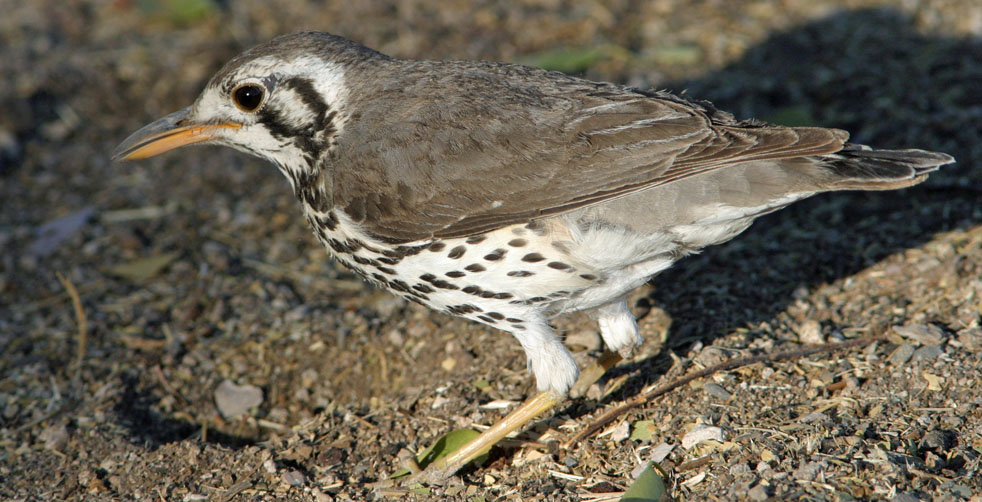 |
|||||||||
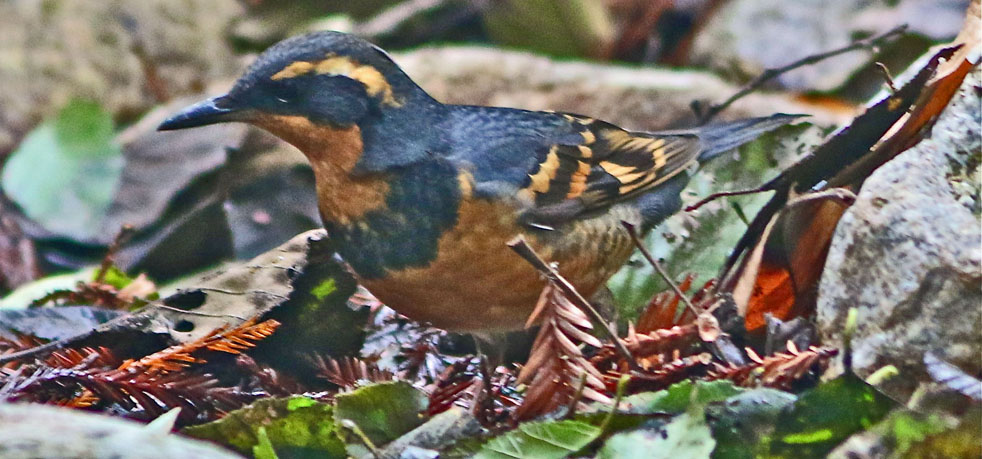 |
|||||||||
Back in November 1977, I found this particular Varied Thrush (right) at a bleak one-tree-oasis in Death Valley, California. It is a very odd individual and must have been an immature female (lacking a breastband) but it also lacked all orange tones on the breast and supercilium. This proved to be an example of schizochroism: washed-out plumage from a lack of a pigment. There had only been one prior California specimen of this eccentric plumage published. Oddly enough, the only vagrant Varied Thrush to reach the British Isles — establishing a first record for the Western Palearctic — was another schizochroistic individual (Madge et al. 1990). |
|||||||||
 |
|||||||||
|
|||||||||
The remaining seven species are shy, often crepuscular, long-legged nightingale-thrushes from Mexico south to the Andes [Spotted Nightingale-Thrush is shown below from a long-ago digitized slide]. Another familiar Catharus thrush in California is Hermit Thrush (both shots below). The species breeds widely in forests of northern North America, and the mountain ranges of the west, and (sparsely) in redwood forests to central California. Its haunting songs are heard dawn or dusk in breeding habitat, but it is much more familiar as a wintering species in many lowland wooded habitats, and in montane chaparral. Hermit Thrush gives its winter "chup-chup" calls often; enjoys a bush full of ripes berries, and often flicks its rusty tail up and shivers its wings. Shown below is a full-throated songster on territory in Alaska (below left), and a berry-hunting winterer here in Monterey Co., California (below right). |
|||||||||
|
|||||||||
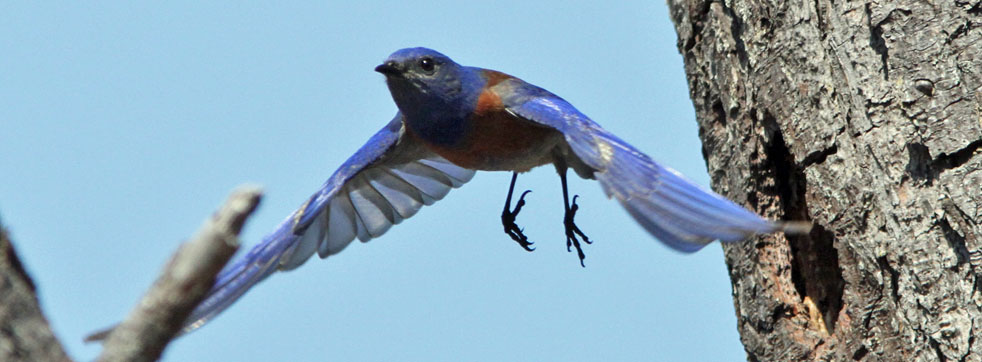 |
|||||||||
Here (just above) is a male Western Bluebird flying from its nest-hole in a old pine tree. In fact, this nest represented the first nest in Pacific Grove (where I live) in the last 50 years. I have a web page on this topic that includes photos of the female and eventual fledglings. That was back in 2012. Today, Western Bluebird has made a remarkable comeback locally. Pairs now breed widely in Pacific Grove and Pebble Beach. And here's a hungry male Western Bluebird atop a bunch of pyracantha berries (right). |
|||||||||
These large thrushes often sing lovely songs; they hop on lawns or in gardens listening for earthworms and pull them from the soft earth; and their nests can sometimes be easily found (active nest with young of an American Robin, right). Indeed, they are considered a harbinger of spring in temperate climates. |
|||||||||
|
|||||||||
Photos: The vagrant hatch-year Mountain Bluebird Sialia currucoides was at Pt. Pinos, Monterey Co., California, USA, on 12 Oct 2009; the adult male was near San Lucas, Monterey Co., on 25 Jan 2015. The Orange-headed Thrush Geokichla citrina was at Khao Yai NP, Thailand, on 26 Dec 2012. The American Robin Turdus migratorius was at Davou Park, Lexington, Kentucky, USA, on 26 May 2019. The adult feeding a fledgling Island Thrush Turdus poliocephalus was at Kumul Lodge, Papua New Guinea, on 12 Sep 2016. The food-carrying male Eurasian Blackbird Turdus merula was in Vondelpark, Amsterdam, Holland, on 7 July 2013. The Rusty-backed Thrush Geokichla erythronota was at Tangkoko Reserve, Sulawesi, Indonesia, on 14 Oct 2011. The Geomalia Zoothera heinrichi at Lore Lindu NP, Sulawesi, on 27 Sep 2011. The Alpine Thrush Zoothera mollissima was along Lingmethang Rd., Bhutan, on 21 Mar 2019. The road-killed Scaly Thrush Zoothera dauma was found dead on the Jakar to Trongsa Rd., Bhutan, on 26 Mar 2019. The hyped-up Groundscraper Thrush Psophocichla litsitsirupa was in Kruger NP, South Africa, in July 1996, and the close-up was taken at Etosha NP, Namibia, on 21 July 2005. The close-up Varied Thrush Ixoreus naevius was along the Big Sur River in Pfeiffer-Big Sur SP, California, on 2 Jan 2018; the schizochroistic Varied Thrush was totally lost at Emigrant Ranger Station, Death Valley NP, California, on 17 Nov 1977. The Townsend's Solitaire Myadestes townsendi was at Cone Peak, Monterey Co., California, on 17 Jan 2015. The singing Cuban Solitaire Myadestes elisabeth was at Cuevo Portales, Cuba, on 6 Feb 2017. The 'Oma'o Myadestes obscurus was at Hakalau Reserve, Hawaii, on 2 Jan 2012. The Swainson's Thrush Catharus ustulatus was at our birdbath in Pacific Grove, California, USA, 11 May 2019. The Spotted Nightingale-Thrush Catharus dryas was at El Triunfo Reserve, Chiapas, Mexico, on 5 Apr 1986. The singing Hermit Thrush Catharus guttatus was on Hershey Mt., Alaska, on 8 July 2011; the berry-hunting Hermit Thrush was at Laguna Grande Park, Seaside, California, on 28 Dec 2020. The nesting Western Bluebird Sialia mexicana was in Pacific Grove, Monterey Co., California, on 5 May 2012; the berry-eating Western Bluebird was at Lagunita Mirada, Monterey, on 9 Jan 2021. The nest with young of American Robin Turdus migratorius was in the parking lot of Devils Tower Nat'l Monument, Wyoming, on 15 June 1998. The Song Thrush Turdus philomelos was in Vondelpark, Amsterdam, Holland, on 7 July 2013. The Rufous-bellied Thrush Turdus rufiventris was along the Rio Claro in the Pantanal of Brazil, on 19 July 2010. The White-eyed Thrush Turdus jamaicensis was along Ecclesdon Rd., Jamaica, on 15 Feb 2017. The Chestnut Thrush Turdus rubrocanus was in the Changqing Reserve, Shaanxi, China, on 9 Nov 2010. The Olive Thrush Turdus olivaceus was in Kirstenboch Gardens, Cape Town, South Africa, in July 2005. The Red-legged Thrush Turdus plumbeus was at Bermejei, Cuba, on 8 Feb 2017.The female White-collared Blackbird Turdus albocinctus was along the Lingmethang Rd., Bhutan, on 21 Mar 2019. The White-backed (Kessler's) Blackbird Turdus kessleri was on Huzu Pass, high in the mountains of north Qinghai Province, China, on 22 June 2004. All photos © Don Roberson; all rights reserved. Family book: Rating
The preceding review was initially put on-line in 2000, and briefly updated recently. Clement's Thrushes (2000) discusses the concept that he intends that books on thrushes and muscicapids will be a "two volume" approach. As the overall project began in 1990, it took 25 years to complete. Since Clements' Robins & Chats (2015) covers some thrushes left out of Thrushes — American bluebirds, Asian cochoas, and Bornean fruit-hunter — I repost below my recent brief review of the second book in Clements' set. Family Book: Rating
Another fine introduction to the entire Turdidae, with some outstanding photos, is presented by Collar (2005), although it does include many genera that are now considered to be muscicapids. In the Handbook of the Birds of the World series, Taylor (2006) covered the then-much-restricted Muscicapidae. Literature cited:
|
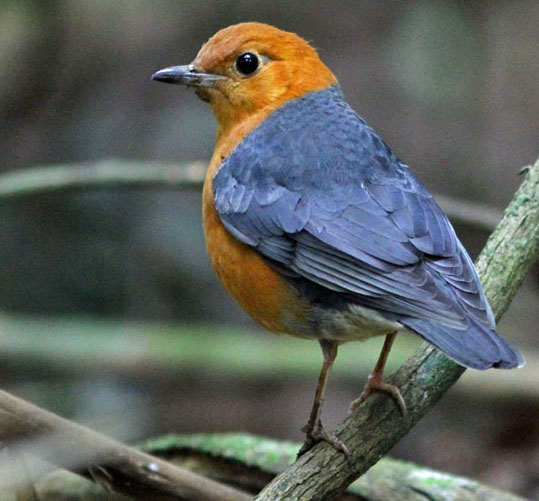 The Turdidae is a rather large family of small to medium-sized songbirds that have ten primaries and a turbine 'thumb' on the syringe. Many are accomplished songsters, and some have vocalizations that are among the most lovely on earth. It has been difficult to define this family as its boundaries were constantly changing before the advent of molecular analysis early in the 21st century. After publications of genetic research in 2010 (Sangster et al. 2010, Outlaw et al. 2010), about half of the species in Turdidae were transferred to Muscicapidae, greatly enlarging what had been know as "the Old World flycatchers" up to that point (a bit more details below; see also Taylor 2006). Now all rock-thrushes, whistling-thrushes, Old World robins & chats, wheatears, alethes, akalats, and allies are muscicapids.
The Turdidae is a rather large family of small to medium-sized songbirds that have ten primaries and a turbine 'thumb' on the syringe. Many are accomplished songsters, and some have vocalizations that are among the most lovely on earth. It has been difficult to define this family as its boundaries were constantly changing before the advent of molecular analysis early in the 21st century. After publications of genetic research in 2010 (Sangster et al. 2010, Outlaw et al. 2010), about half of the species in Turdidae were transferred to Muscicapidae, greatly enlarging what had been know as "the Old World flycatchers" up to that point (a bit more details below; see also Taylor 2006). Now all rock-thrushes, whistling-thrushes, Old World robins & chats, wheatears, alethes, akalats, and allies are muscicapids.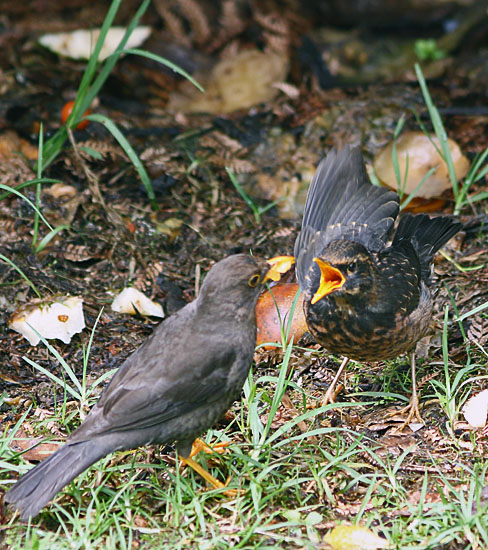 When this page was created in 1999, Turdidae was a huge family of 365 species. By the time that Vol. 10 of the Handbook of Birds of the World was published (Collar 2005), the transfers of some birds to other families had reduced the total to 336 species among 60 genera. Now, molecular research has reduced Turdidae to just 169 species in 18 genera, while Muscicapidae has grown to 322 species among 49 genera. In short, while the Turdidae once had about three-quarters of the muscicapids/thrush group, it now contains just one-third of that group.
When this page was created in 1999, Turdidae was a huge family of 365 species. By the time that Vol. 10 of the Handbook of Birds of the World was published (Collar 2005), the transfers of some birds to other families had reduced the total to 336 species among 60 genera. Now, molecular research has reduced Turdidae to just 169 species in 18 genera, while Muscicapidae has grown to 322 species among 49 genera. In short, while the Turdidae once had about three-quarters of the muscicapids/thrush group, it now contains just one-third of that group.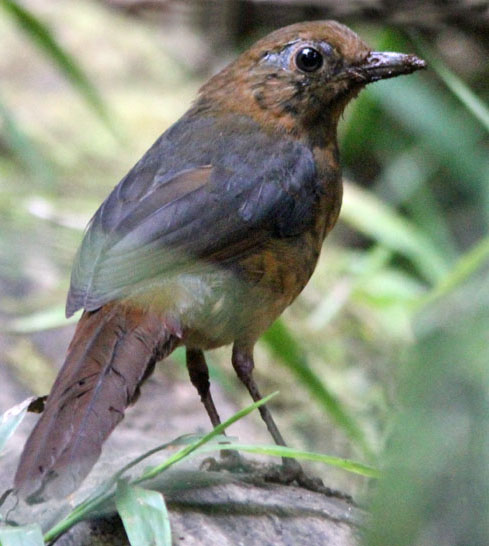 We will return to Turdus thrushes later, but there 17 other genera in the family — 9 in the Old World and 8 in the New World. Only Turdus is a worldwide set of large thrushes.
We will return to Turdus thrushes later, but there 17 other genera in the family — 9 in the Old World and 8 in the New World. Only Turdus is a worldwide set of large thrushes.

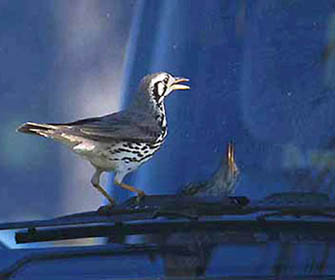 In Africa, there are four species of elusive deep-forest birds in genus Neocossyphus: these are called flycatcher-thrushes (2 species) and ant-thrushes (2 species). The latter are not remotely related to the antthrushes of the Neotropics (family Formicariidae), but they are reclusive, terrestrial birds. In addition, Groundscraper Thrush is assigned to its own genus (Psophocichla): it has characters, such has contrasting facial and underpart patterns, that recall Zoothera thrushes of Asia.
In Africa, there are four species of elusive deep-forest birds in genus Neocossyphus: these are called flycatcher-thrushes (2 species) and ant-thrushes (2 species). The latter are not remotely related to the antthrushes of the Neotropics (family Formicariidae), but they are reclusive, terrestrial birds. In addition, Groundscraper Thrush is assigned to its own genus (Psophocichla): it has characters, such has contrasting facial and underpart patterns, that recall Zoothera thrushes of Asia. 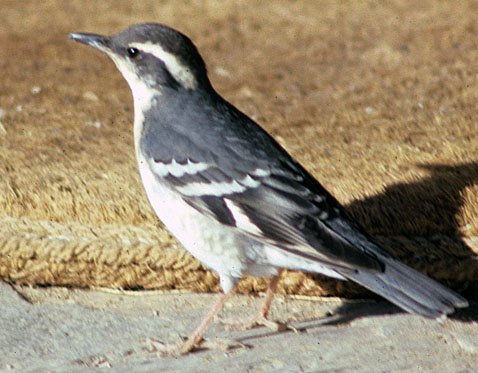 In North America, the retiring, ground-loving thrushes that recall the Zoothera thrushes of the Old World are the monotypic Aztec Thrush Ridgwayia pinicola, endemic to montane forests of west and central Mexico, and the western North American Varied Thrush (above and right). These are secretive, easily-overlooked forest species. Varied Thrush is migratory but it is so shy that its prolonged call-note, in a distinctive minor tone, is often the only evidence that one is around.
In North America, the retiring, ground-loving thrushes that recall the Zoothera thrushes of the Old World are the monotypic Aztec Thrush Ridgwayia pinicola, endemic to montane forests of west and central Mexico, and the western North American Varied Thrush (above and right). These are secretive, easily-overlooked forest species. Varied Thrush is migratory but it is so shy that its prolonged call-note, in a distinctive minor tone, is often the only evidence that one is around. 

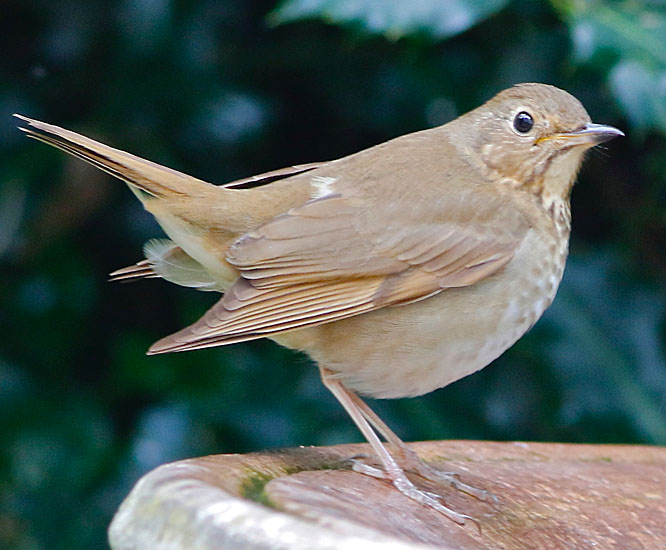 The New World has 12 species of Catharus thrushes — many of them exceptional songsters — plus Wood Thrush Hylocichla mustelina of eastern North America, another fine singer. Five Catharus thrushes and Wood Thrush are migratory species that breed in North America and move south to wintering grounds from the southern U.S. to the Caribbean and Middle & South America. One of these is Swainson's Thrush, a species with distinctive subspecies east and west (left, a western race shown). These are secretive in migration, but at night we sometimes hear dozens calling high above as they fly over.
The New World has 12 species of Catharus thrushes — many of them exceptional songsters — plus Wood Thrush Hylocichla mustelina of eastern North America, another fine singer. Five Catharus thrushes and Wood Thrush are migratory species that breed in North America and move south to wintering grounds from the southern U.S. to the Caribbean and Middle & South America. One of these is Swainson's Thrush, a species with distinctive subspecies east and west (left, a western race shown). These are secretive in migration, but at night we sometimes hear dozens calling high above as they fly over.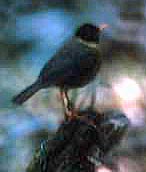


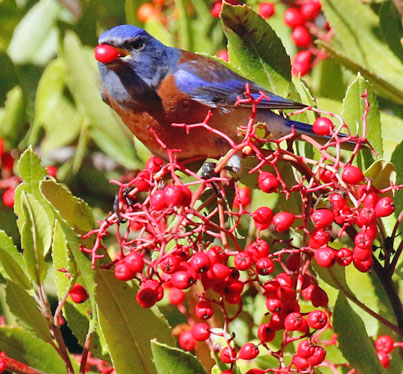 Finally, North America has three species of bluebirds (genus Sialia). The migratory Mountain Bluebird is featured in two plumages within the 3 photos at the top of this page. Eastern Bluebird S. sialis and Western Bluebird are essentially resident species in eastern and western North America, respectively.
Finally, North America has three species of bluebirds (genus Sialia). The migratory Mountain Bluebird is featured in two plumages within the 3 photos at the top of this page. Eastern Bluebird S. sialis and Western Bluebird are essentially resident species in eastern and western North America, respectively. 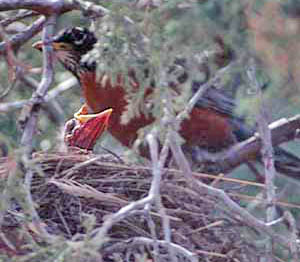 We can wrap up this review of the Turdidae with a few more Turdus thrushes, the genus that represent half of the species in the family. There are native Turdus thrushes on all continents except Australia and Antarctica (and introduced Turdus in Australia and New Zealand). The taxonomic parameters of this large genus is now reasonably well sorted (Voelker et al. 2007, Voelker & Klicka 2008, Nagy et al. 2019).
We can wrap up this review of the Turdidae with a few more Turdus thrushes, the genus that represent half of the species in the family. There are native Turdus thrushes on all continents except Australia and Antarctica (and introduced Turdus in Australia and New Zealand). The taxonomic parameters of this large genus is now reasonably well sorted (Voelker et al. 2007, Voelker & Klicka 2008, Nagy et al. 2019). 







